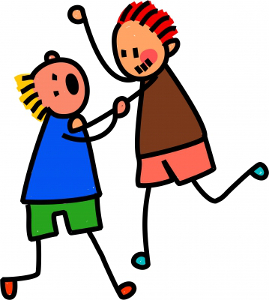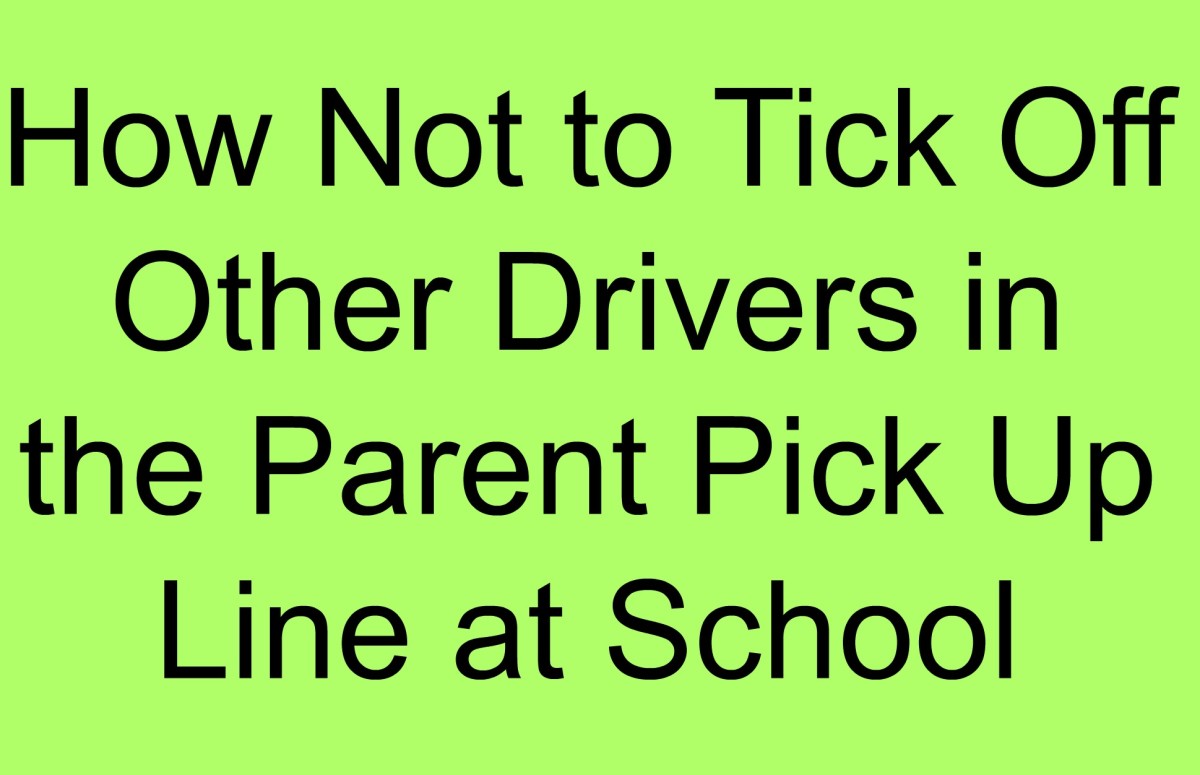- HubPages»
- Family and Parenting»
- Parenting Skills, Styles & Advice»
- Parenting Advice & Tips
Teaching Kids to Use Their Internal Guidance System
"As a parent, you have to be open to helping your child through confusing emotions and peer pressure." -- Sharon Ballantine
Do you think that teaching kids to use their IGS instead of directing their every move is a good idea?

Note to Kids: Neither Bully nor Victim Be
When it comes to bullying in school or in public, your kids are generally taught to avoid being the victim or the bully. However, peer pressure and bully behavior is still prevalent in schools, and when it comes to growing up, it’s logical to assume that everyone will either experience or see some form of bullying happen to someone else.
Nobody wants their kids to be bullied. There are many programs aimed at helping kids avoid becoming the victims of bullying.
Most parents know that bullies exist, but few parents believe that their child could possibly be bullying other kids.
So who are the bullies? What exactly is bullying? How can you be sure that your child is neither being bullied, nor the one who is doing the bullying?
For many people, when they hear the term “bully,” they picture some bigger kid picking on younger or smaller kids. Sometimes this includes verbal taunting, physical threats, or even stealing anything from lunch money to the latest fashion accessory.
Bullying is much more than that. According to the website StopBullying.gov, bullying is defined as “unwanted, aggressive behavior among school-aged children that involves a real or perceived power imbalance.” The specific behavior may be repeated or there may be a fear that it will be repeated.
Behaviors not only include the physical and verbal threats or attacks, but they also include spreading rumors and even excluding an individual from a group or activity.
Bullying doesn’t stop at school or even at the neighborhood park. Cyberbullying is behavior that is conducted online, whether via text messages, emails, or social media sites.
Peer pressure often leads kids who would not otherwise be bullies to participate in this antagonistic behavior. These kids may actively participate in the behavior, or they may support the behavior by laughing or otherwise encouraging it.
Whether your child engages in bullying behavior or has been on the receiving end of bullying, it’s important to note that they may be at greater risk for depression or suicidal thoughts than other kids.
By teaching your kids to tap into their Internal Guidance System (IGS), you can help them stop bullying. If your child has witnessed someone else being bullied, but didn’t know what to do, have them go inside themselves and feel what it would be like to be the child who’s under attack.
Ask them how it would feel to have other classmates stand by and do nothing. Then ask them how it feels to have someone stand up for them and help end the bullying.
If your child has actively participated in, or has supported or encouraged bullying behavior, they can also use their IGS. Have them feel what it would be like to be the one on the receiving end. How does it feel to be isolated and made fun of? How does it feel to be threatened or to have something taken from them?
Then ask your child, knowing how it feels to be the one who was bullied, how they feel about their behavior after considering their own feelings? Are they proud or happy? Or do they feel embarrassed or sorry? If they continue to listen to their IGS, they’ll now have a better idea of what their next steps should be, including apologizing for their actions and changing their behavior in the future.
If your child has been the one who was bullied, they can also tap into their IGS and attempt to feel how the other kids felt. They may be able to feel that some of them were confused, some felt pressured to conform, and some were afraid for themselves.
When you recognize that bullying behavior is about attempting to exert power that one doesn’t otherwise feel, you may become aware that the kid doing the bullying is also afraid and feeling powerless elsewhere.
This awareness can allow the child who was bullied to have a greater understanding of the situation and take actions that may include forgiving the aggressor or helping other kids who are getting bullied without resorting to violence.
As a parent, you have to be open to helping your child through confusing emotions and peer pressure. By teaching them to trust in their IGS, they’ll have the skills to withstand that pressure, to be supportive of one another, and to help end bullying behavior in person and online.

Why Parents Should Encourage Listening to the Body
Kids and parents both face challenges of fitting their lives into schedules. For most families, these schedules are imposed by forces outside of their control. Those forces may be the parents’ jobs or the kids’ schools, not to mention all the extra-curricular activities and obligations people face that demand their immediate attention.
Today’s lifestyle and societal demands stress a need for you to focus on the clock on the wall more than your own internal body rhythm.
If you want to be part of society, you set your alarm to wake up in time to shower, dress, hopefully eat, and get to work or school on time.
You take breaks when the boss/teacher/bell allows. You eat lunch within a specific hour.
For many people, exercise is only to be found in the form of moving from one event to another. Either that or it’s also tightly scheduled, perhaps in a class, sports team, or fitting it between your commute and work life.
When your children are newborns, they’re also on their own schedule. They let you know when they’re hungry. Their little lives revolve around eating and sleeping and your life revolves around theirs.
Soon, you’re exhausted from too little sleep and begin to train your babies to go longer between feedings. This is the beginning of teaching your children to ignore the signals from their bodies in order to conform to a standard schedule.
For most parents, this shift is a necessity and it’s not wrong. Yet it’s still something that you should be aware of. You might be asking yourself, “What’s so bad about teaching kids to adhere to a schedule?”
Ignoring the signals your body gives you can lead to a complete disconnect that’s unhealthy. You learn to ignore or not even recognize your hunger symptoms. Instead of “grazing” throughout the day as your ancestors did, you eat larger quantities of food at one time.
The goal is to have your kids adhere to a schedule – such as everyone in class paying attention while class is in session, but eating later. Unfortunately, the results can backfire on teachers. Kids who are hungry during class find it harder to concentrate, become fidgety, and can distract their fellow students. On the other hand, famished kids tend to overeat at lunchtime, which can create lethargy, again making concentrating on lessons a challenge.
Taken to an extreme, you turn your body’s signals off. When you don’t listen to your body’s cues to eat long-term, you find resulting obesity and anorexia; opposite sides of the same illness.
Forcing kids to only exercise when directed to encourages them to ignore their body’s desire to move. Soon, instead of longing to go outside and play and be physically active by having fun, the only physical activity they get is part of an organized plan directed by a parent, teacher, or coach. Long-term, this results in poor health and obesity.
Some children do really well and even thrive on a schedule. Other kids will do better with some flexibility in their lives. Be sure to pay attention to your children and how they react. If they’ve already become conditioned to a schedule, you may have to help encourage them to recognize their body’s cues when it’s time to eat, move their bodies, or even get some sleep. If your children are natural grazers or in other ways seems to automatically know what’s best for them, help support that intuitive behavior.
At first, it may be a challenge to shift from running your entire life based on the time. And there will certainly still be things that you cannot change. Yet when you’re in touch with your body’s wisdom, you’ll have maximum health and pleasure in your life. Isn’t that what you want for your children?
"Forcing kids to only exercise when directed to encourages them to ignore their body’s desire to move. "
— Sharon BallantineMore from Sharon About Law of Attraction Parenting
- Beliefnet Voices - Sharon Ballantine - Parenting on Purpose
Beliefnet Voices – Sharon Ballantine
Life After College

Summer and Kids: Wasting or Biding Their Time
Now is the time when kids and parents are making plans for the summer. Some kids have no problem figuring out what they want to do. They may actually have a list of things they want to accomplish and it’s so long that it makes climbing Mt. Everest seem like a walk in the park. Truth be told, most kids just want to hang out.
Parents often feel torn about summer. They want their kids to have fun, but they don’t want to see the time being wasted either.
Parents might encourage kids to take classes, enroll in a summer sports program, attend camp, or even get a job.
There’s nothing wrong with any of these activities. The problem comes in when you try to direct your kids out of a sense of needing to keep them busy.
Perhaps you have a concern that your son or daughter will get into trouble if they aren’t busy. The thing is, if kids want to get into trouble, they’ll still find a way no matter how full you keep their schedule.
Rather than filling their summers with structure and schedules, check in with your kids and discuss how they want to spend the summer. Have the entire family talk about what they’d envision as a perfect summer. Include your thoughts about what would feel good for you. The goal is for each family member to talk about their summer and what they want individually, not what they want for anyone else.
So if your daughter just wants to hang out at the mall with her friends, don’t freak out. Try to delve deeper and see what she really wants. If she wants to be at the mall because she thinks she’ll be buying a lot of clothes, you can help her understand that she needs a way to pay for those clothes. If she wants to hang out because she’s tired from working hard all school year, perhaps some time off is warranted.
Each family member should check in with their Internal Guidance System (IGS) to feel what the right course will be for them. This isn’t a one-time check, but something that everyone should do on a regular basis. A lazy summer may feel good at first, but that feeling may shift. When it does, kids should have the freedom to change their minds about how they want to spend their summer.
Sure, some options won’t be available to them if they don’t plan ahead. They might not be able to get into a class or a scheduled program. It’s possible that it’ll be harder to get a job. On the other hand, if they’re truly ready and eager, then they can actually attract the right situation.
For much of the year, kids have highly scheduled lives. Let your kids take a little time off this summer. Check in with your own IGS and see how it feels to reframe the idea – they aren’t wasting their time. They’re biding their time. If your whole family approaches the summer with the idea of making it great, then you all might just experience their best summer ever.

Modern Solution to the Endless Why, Why, Why?
Kids are naturally very curious. This is something about kids that’s so much fun to be around and to foster. A lot of things are new to them and for them to learn about their world and interpret it in their own way is a key part of development, yet despite all this, the endless stream of “why?” that can come out of their mouths can be frustrating.
When you remember that this is a sign of their curiosity, intelligence, and growth, your frustration can be softened and a good way to reduce your “why fatigue” is to use their questions as a learning opportunity – for you as much as for them.
Your kids look up to you and expect you to have all the answers to their questions. They expect that because you’ve taught them that you do.
It’s okay to let them know that you don’t actually know everything. In fact, it can be very healthy for them to learn that you don’t have all the answers — and more importantly, that it’s okay to not to.
What you need to remember is that while knowledge is wonderful, no one human being knows it all. Not even the smartest person in the world has all the answers. On top of that, having “all the answers” is not a very important skill in real life. Knowing how to get the answers on the other hand, is.
When your kids ask questions, you can use their curiosity and turn it into a lesson on how to gather information in ways other than asking Mom, Dad, their teacher, or a friend or sibling.
This goes beyond telling a child to look up a word in the dictionary if they don’t know how to spell it like you were taught as children. That isn’t a great teaching lesson. After all, how many kids looked at the teacher or parent who said this to them and said, “How can I look it up if I don’t know how to spell it?” Countless more had the question run through their mind, but didn’t have the courage to say it out loud.
This is a lesson in both patience and empowerment. Rather than expecting someone to be able to immediately recite and know the answer to their question, kids will learn that some things take time. It also gives them independence from others when they learn how to find answers for themselves.
In the “good old days,” you might’ve looked things up in a big set of encyclopedias. Mostly, you had to make a trip to the library or might’ve even had a personal set at home if you were lucky. Although the encyclopedias were cumbersome and went out of date rather quickly, there was something to be said for opening a volume from the set and reading about a variety of topics. It was a great way to quench a thirst for knowledge and to also spark an interest.
Today, kids don’t have to carry around a set of encyclopedias. Most kids have access to computers with capabilities previous generations never dreamt of and by simply going to a favorite search engine and typing in a question, your children can get the answer to their exact question.
The downside to this approach is that while they get the answer, they may not continue to read more about the flower or the butterfly as you might have with the encyclopedias.
Another downside to relying on Google for the answer is that not all information on the Internet is truly reliable. It can be important to use critical thinking skills when checking things out online or you might come up with some misinformation. Just as when you were growing up, be sure that your kids know they can’t believe everything they read -- just because something’s written in a book, newspaper, or on the Internet, it doesn’t mean that what’s on the page is true.
Help your children navigate the world of the search engine and you’ll be giving them a research tool that they can use throughout their school years.

Cell Phones and the Internal Guidance System
When you first talk to your kids about using their Internal Guidance System (IGS), it can seem like you’re speaking a foreign language. While some kids are good at listening to what their parents say and translating the information, many aren’t.
Even for kids who are auditory learners, new concepts can be difficult. Using references and visual aids can really help to make your message clearer.
There’s a tool at hand that most kids are familiar with that you can use to help describe the IGS and you probably have one in your back pocket or purse.
For that matter, you may even be reading this article on one – that’s right, I’m talking about your cell phone.
Think about how you use your smart phone. You gather information with it and look for things that you want. Whether you’re shopping or doing research, your phone has the ability to find and bring up whatever you want it to.
Does that sound like your IGS?
Tapping In
When you have a conversation with a friend, part of that conversation involves listening. If you never listened, it’s safe to assume you wouldn’t have many friends. Without listening, you wouldn’t make the connection with the people you care about.
You’ve likely had phone conversations that were filled with static or where the call was dropped because someone went out of cell coverage range. Sometimes you have to strain to listen to hear a caller’s words over the wind or other conversations in the background. You’ve also had serious conversations with friends where you speak quietly because you don’t want others to overhear. And when your friend is telling you something very important or serious, you listen attentively.
Tapping into your IGS is a lot like calling a friend; except with your IGS, you’re calling your own inner wisdom.
When you’re connected with your IGS, you still have to listen attentively. Your IGS may speak to you in whispers, so you need to be quiet so you hear the message. If you have too many distractions, you may lose the connection and miss what you were supposed to hear.
Information Gathering
Your IGS collects data constantly. You add information to this databank without even noticing that you’re doing it. You try things and discover that you like it or you don’t, having a pleasant experience or an unpleasant one. You feel hurt or exhilarated.
All of this information is stored for you, just as your smart phone stores phone numbers and websites. You can easily return to those places on your phone or use those sites to help you determine where you want to go next.
By checking your IGS, you can revisit experiences you’ve had in the past and know if the direction you’re heading in is going to be something you want or not. Your IGS will help you remember how you felt in the past so you don’t have to go there again. It can also help you understand how others might feel.
As long as you’re willing to listen to your inner wisdom with all of your stored preferences and the lessons you’ve learned, we can better steer yourself into a better future course. You can also them help your children make the best decisions for their unique personalities and lives.

When Your Kid is an Extrovert but You Aren’t
When your kids are born, they may inherit your blue eyes or black wavy hair while they receive your significant other’s body type or mannerisms. What’s more, they may receive some of your work ethic, but the social skills of a stranger. Where did you find these kids? Are they aliens?
The answer is obviously not at all, but at some point or another, all kids will show how different they are from their parents.
For you as their parent, this can be exciting, wondrous, and even a bit scary, all at the same time.
When we have a child whose personality is extremely different from one parent or both, it can be a challenge, but as long as you’re willing to learn and make some adjustments, it doesn’t have to be a major concern.
For example, if you or your spouse are introverted, it doesn’t mean that your child will be also. It can be stressful for introverts to live with extroverts and vice versa. It can also lead to feeling like you’re on different sides of the planet and that you don’t understand one another.
Don’t expect your child to automatically follow your style. They’ll pick up on your energy, even unconsciously, and this can confuse them too. They may modify their behavior, thinking it’ll be to better fit in. In that effort, they’ll probably feel like they don’t belong; that they’re only accepted when they aren’t being authentic to their inner voices.
You want your kids to be comfortable around you and in the world as much as possible. You also want them to be happy. In order to achieve that, your kids must be able to feel like they’re being authentic and not pretending their way through life.
When your kids feel like they’re masking their true selves, it’s an indication that they’re not listening to their Internal Guidance System (IGS). Their IGS is working – it’s telling them to follow their unique path, but they’re resisting that wisdom in an effort to fit in.
In the case of the extroverted child living with introverted parents, it might mean that they’re figuratively bouncing off the walls. They may censor their comments while in your presence because they feel your discomfort. They may spend less and less time at home as they get older.
This is why it’s important for parents to learn what it means to be an extrovert as opposed to an introvert. It isn’t that the introverted parent should attempt to become an extrovert. That would be just as wrong as the extroverted child trying to adopt their parent’s temperament.
Rather than anyone trying to become someone they aren’t, it’s good to understand that there are different ways people can process information. The introvert will process internally. Sometimes you’ll hear people say things like “I can see your wheels turning,” meaning they recognize the introvert is thinking through a situation.
On the other hand, extroverts process information externally. They’ll tend to verbalize the process they’re going through to reach their conclusion. The extrovert may not be aware that it’s even possible to process information silently. They may falsely believe that the introvert has jumped to a conclusion without considering and weighing all available options or hasn’t given a problem due consideration.
Your extroverted child deserves to understand that not everyone needs or wants to talk the process through. It will help them to see that other people aren’t being overly judgmental if they recognize that another person is an introvert and processes things differently.
This’ll help them in the future when they’re dealing with your reactions. They may still ask you to explain your response or they might still accuse you of not understanding them -- but every child has those feelings at least once or twice while growing up.
Learning to live with people who process information in a different manner will help them with other relationships as well. They’ll be better equipped to deal with and get along with people who have different styles, including friends, teachers, co-workers and employers. They may even surprise you and gravitate towards other introverts naturally.
If your child is an extrovert and you aren’t, you may have to step out of your comfort zone from time to time. Reassure them that you hear what they’re telling you. Let them know that you value their thoughts and give them the opportunity to express their ideas.
However, don’t neglect your own Internal Guidance System (IGS) and your own feelings. Make sure you give yourself adequate quiet time and be willing to ask for it. This will allow you to recharge and be fully available for your child. They’ll appreciate having you truly be present rather than only partially there, so ask for what you need and allow them to ask for what they needs. Everyone will be better off.

Selective Sharing in a Tell-All World
In the days of social media, texting, and “being honest,” teenagers can sometimes feel like they should be able to tell their friends everything. Sharing secrets with friends is nothing new. Everyone’s done it and having at least one really close friend in whom your kid can confide is a very valuable asset. That is a person to be cherished.
However, there’s also the experience of sharing something with someone you thought was a friend, only to have that so-called friend share your secret with others.
When you were growing up, it was probably embarrassing when your classmates knew your secrets because they heard them “through the grapevine.”
Now imagine what it’s probably like for a teenager when it seems like the entire world learns their private business on Facebook, Twitter, Whisper, Instagram, Snapchat, or any other social sharing site that is popular with kids today.
There many reasons for you to be concerned about your teenager’s activities on websites. There’s always the “stranger danger” aspect associated with the Internet. Kids may think they’re communicating with someone their own age when they’re actually in contact with an adult with nefarious reasons for chatting. However, that’s not the only aspect of these websites that you might find concerning as a parent.
The anonymity of the sites creates a layer of insulation. This layer may encourage teens to share more than they might with a person they just met in real life. It might feel safer to talk about experiences or fears with someone who attends another school or lives far away. Unfortunately, geographic distance doesn’t mean a secret is safe in the age of cyber communications.
This insulating layer works in the other direction as well. Your teen might not be the type to gossip about another or tease someone in person. Unfortunately, it’s easy to get caught up in spreading rumors or speaking unkindly about someone that they don’t really know. The person they’re unintentionally smearing doesn’t seem as real from behind the safety of a computer screen. This is what allows cyber-bullying to happen and even good kids can get caught up in speaking poorly about another because of this false sense of insulation.
Teenagers tend to text and chat online like they’re talking with close friends in person. By that, I mean they don’t necessarily take the time to think about the impact of their words or to choose their words carefully.
Unfortunately, when a teenager uses these sites, these conversations aren’t always private. In most cases, your kids’ words are open for many other people to see -- even if the privacy settings restrict conversations to specific people.
Instead of just a supposedly close friend opening their mouths to share your teen’s private business, they can now forward and repost the exact messages and tweets with the secret in them to whomever they want. With that proof, any secret or poor choice of words is stronger than the gossipy whispers from your own youth.
One thing you can talk to your son or daughter about is “selective sharing.” Kids might try to test the sharing waters with friends, especially new ones, so you may want to guide them towards not sharing secrets of any kind in writing. And encourage them to build trust in a friend over time, before giving over a any secret at all.
Some teens think they’re protecting themselves because they’ve carefully instructed their confidante not to tell anyone their secrets. Sadly, this doesn’t always work. In fact, teenagers are known for letting things leak out of the “vault” on accident. Let’s face it. Some people, adults included, are good at keeping secrets, but others find it impossible to refrain from finding someone else to share a secret, big or small, with.
Neural linguistic programming stresses that when one includes a negative in a command, as in “don’t tell,” the subconscious mind doesn’t hear the “do not” and instead registers it as “tell.”
As an adult, you know that the only way to truly keep a secret is to tell no one. You also know how difficult it can be to live with a secret. Keeping things to oneself isn’t always the healthiest choice. But you can help your teenager to avoid being the subject of gossip and bullying by creating a safe environment at home for them to share their feelings. Teaching them to share their secrets with others selectively, and never online, is probably the best course of action.
Gently mention to your kids that a secret you don’t want other people to know should never be put into writing, especially online. Those secrets can always come back to bite them, at the simple click of a mouse.

Kids, Like Plants, Benefit from Being Left Alone
You love your kids. You want them to be safe and to have a wonderful childhood. You want to spend time with them, support them, and to have fun together. All of these desires that you have for your children are good things, but like with many good things, it’s possible to go too far.
If you’ve ever tended a garden or even had a couple of indoor plants, then you know most plants benefit from a certain amount of benign neglect. They need the right amount of water and sunshine -- neither too little, nor too much.
Plants need an occasional dose of fertilizer, but other than that, plants don’t need a lot from you. They seem to do better when you talk to them from time to time. They suffer when your express your anger at them. For the most part, they do well being left alone. Too much tending is unnecessary, nor does it necessarily result in a healthier plant. Sometimes, it can even leave the plant in poorer health.
Kids can also benefit from some alone time. Too much hovering can actually be harmful to kids, just as it can be for plants.
I’m certainly not suggesting that you neglect your kids and they definitely benefit from more attention than you might provide your plants, but in order to grow and blossom into the unique human beings they can be, they need to have some time apart from their parents. They need time to stretch out and reach for the sunlight in order to find where their roots want to go.
The idea of leaving kids alone can be scary for any parent. It’s easy to imagine all sorts of horrible things happening to them. You can also envision their feeling neglected, even if you have the best intentions.
I wish there were a simple formula in order to know how much alone time a child needs. Like plants, that varies, and many different factors will influence this. It’s important to consider your specific child, their tendencies, personality, age, and preferences.
What may seem warm, loving, and attentive to one child can feel smothering to another. One sibling may long for more parental involvement and another may seek more independence. Hanging around your kids and attending all their sporting events may feel supportive or it can feel like “hovering.” Hovering can lead to your children not knowing how to act and think for themselves when you aren’t around.
Of course, these needs can and will change over time. Most parents experience times when their kids want very little to do with them and others where their kids can’t seem to get enough attention. Some of this is rather predictable and age-related. Even then, there will be variations among children because of their personalities and what’s going on in their lives at home and at school.
Your Internal Guidance System (IGS) is a great tool in helping determine if you’re giving your children the right amount of attention. Your IGS will help you recognize how it feels if you’re going overboard and at risk of creating a child totally dependent on you or one who resents your presence. On the other hand, you’ll be able to sense when your child is looking for more attention, whether that is companionship, support, or guidance.
Keep in mind that kids need some alone time in order to use their minds and imagination fully. It’s also very healthy for children to learn to be okay with being alone and to be comfortable with their own companionship.
When kids aren’t comfortable with being alone, they then seek other people to fill that void. You may be able to take that spot now, but what’ll happen after they’ve left home? Will they rush into relationships because they’re uncomfortable being by themselves? This happens to a lot of people.
By “neglecting” your kids and giving them time without you, you may actually be giving them one of the greatest gifts. They’ll learn that it’s okay to be alone. They’ll be able to be comfortable, happy, and productive without constantly needing companionship. They’ll also have a better appreciation for the benefits of having the right person’s company without feeling like they have to have someone around all the time.

Helping Kids Stay Healthy Over the Holidays
If you’ve done any reading over the last fifteen years or so, you’re probably aware that American children are unfortunately less healthy today than they were a generation or more ago. You hear the reports about the epidemic of childhood obesity and read more and more that diseases that used to impact adults only are now hitting children at a higher frequency.
Naturally, you want your children to be as healthy as possible. At the same time, you recognize that you have a lot of things to balance in your life.
Sometimes your schedule -- or our children’s schedules – make eating healthy meals challenging. The typical American diet consists of a lot of fast food, largely because it is faster, simpler, and at least on the surface, relatively inexpensive.
The goals of a healthy diet aren’t just to lose weight. Even children who are at a healthy weight and are physically active deserve to fuel their bodies and their minds with good nutrition and families who generally make good food choices may still have an abundance of special treats and fewer healthy foods available during the holidays.
Combine a lack in good nutrition with a change in routine and it’s possible that you or your children might experience a decline in health around December and January. While some children will bounce back as soon as they return to their normal routine, many people never lose the extra pound(s) they put on.
Rather than having your family’s health deteriorate this holiday season, what if you could help your family to stay healthy?
As a parent, you play an important role in keeping your children healthy all year long -- especially during vacations and holiday breaks. While you love to have special treats available because they have a sentimental association with the season, you can still help keep the ratio of sweets and healthier food choices in balance.
It isn’t just about sweets though. Many holiday dishes are loaded with extra fat, carbohydrates, and salt. All of these items can have an impact on your children’s health and energy.
I’m not suggesting that you have to become the food police. I know from personal experience how that can backfire, so when you try to restrict the foods your children eat, they’ll often rebel. They might actually end up eating more of the forbidden foods or more food in general. This may be done on a conscious level, but generally, it’s done unconsciously. Either way, the end result is still your children’s physical well-being declining.
Rather than attempting to monitor every morsel that goes into another person’s mouth, you can be sure that you have plenty of healthy foods available that are easy to eat. Children love to snack, so being sure that healthy snacks are there in addition to some less than healthy ones is one way to handle it.
Another idea to consider is setting a meal routine. When children are in school, they have a set schedule. If you can, try to follow that schedule as much as possible. Having meals together as a family is another way to increase sensible food habits. Your family can all pitch in to help, especially if the children aren’t in school because of the holidays. This may be the perfect opportunity to have everyone learn a new skill or research a recipe they would like to try out.
In addition to healthy eating, engaging in some physical activity is important for your health. Moving your body is good for muscles and bones and it also helps your brain function better. Activity as simple as taking walks after meals is a good way for the entire family to get some exercise and bond over conversation.
If you live in a part of the country where there’s a lot of snow, consider other physical activities you can do as a family. Perhaps one of your family traditions will be to go ice skating or sledding rather than napping after a big meal. You can even play a video game that gets everyone up and moving -- from Wii Fit yoga to Wii Sports. Don’t have a video game? Turn on the radio and dance. Try mixing up the exercise, but most of all focus on having fun.
Making your family’s health a priority is a commitment. It does take some effort. It may take a little more time to make healthy meals than it does to hit the nearest drive-thru and it requires a conscious decision to get up off the sofa and go for the walk, but the benefits far outweigh that. Give your family the gift of health this holiday season.

My Child Wants a Dog and I'm Not Sure; What Do I Do?
As wonderful as dogs are, the truth is that having a dog is far from essential in regard to having a happy childhood. Deciding to have a dog isn’t an easy decision for many families and if you decide that having a dog isn’t the right decision for your family, that doesn’t make you a bad parent.
Weighing whether or not to have a family dog isn’t something to be taken lightly and there is no one right answer.
For some families, a dog is out of the question, but a smaller animal might be the right solution.
For others, the timing just isn’t right for a pet. Other families will choose to remain dogless forever because of where they live or how little time they have for taking care of the animal.
Many questions come up around having a dog. Sometimes children get excited about the idea because they’ve just seen a cute puppy, a friend has a “cool” dog, or they watched a movie that featured a canine hero or sidekick.
All this aside, some children may not have an appreciation for the work and responsibility that having a dog entails. If they’ve only seen the fun part, they might not even know that there’s any work at all.
Before agreeing to get a dog, it’s important to address your concerns. It is equally important to have a realistic conversation with your child about what it means to bring a dog into the family. Having a pet is a lifelong commitment. It isn’t something that you can change your mind over, such as when you return a pair of shoes that didn’t fit to a store.
You may wonder about who’ll take care of the dog if you say yes. Your child may swear up and down that you won’t have to do a thing, but are they mature enough to take on the responsibility? Keep in mind that maturity isn’t a matter of chronological age. Does your child have the time and ability to take care of a dog? Is everyone else in the family excited about the idea while you’re the only hold out?
Check in with your Internal Guidance System (IGS) to help you figure out exactly what’s holding you back. Do you have a fear of dogs stemming from a past incident? Are your certain that despite their protests, the dog will become your responsibility? Are you concerned about the finances?
Other things to consider include whether you or someone else in the family is allergic to the dog. Do you have other pets that may be affected by bringing a dog into the house? Can you afford to properly take care of dog’s training, vet bills, shots, grooming, and food costs? Do you travel frequently for work? Do you own your own home or do you need to get approval from a landlord before you can consider a dog?
If you believe that bringing a dog into the family is a good idea, but only under certain conditions, then you must be able to articulate those conditions to your child. What happens if your conditions aren’t met? Will you then be forced to find the dog a new home?
Dogs can be a great way for your child to learn responsibility. When they’re responsible for a living being, they can learn that sometimes one has to put others first. Dogs can’t feed themselves or take themselves to the vet. They need to be provided with water, shelter, a safe place to stay when the family’s away from the house, and a place to go to the bathroom. They need exercise and to be played with no matter what the weather is like. Just like a baby, caretakers have to be sure to tend to their animals before they get to go and play with friends or go to bed.
A dog can be one of the most loyal friends, too. They provide a loving wag and a listening ear when you need solace. They provide unconditional love which is an incredible gift and valuable lesson for a child to learn.
Your IGS will help guide you in deciding whether or not having a dog will be a valuable gift at this time or too large a burden for your family to undertake. Allow yourself plenty of time to feel your way through the decision -- all members of the family deserve that consideration.

Do I Really Want to Bring My Children Along?
As much as you love your children, is bringing them everywhere with you always the right decision? If your goal is to keep them with you at all times, then you have some decisions to make. For example, are you going to bring them to that questionably appropriate gathering? Or are you going to relegate yourself to dining at places like Chuck E. Cheese until your children reaches puberty? Below are some reality checks to keep in mind when deciding whether or not to include your children.
Events & Parties
Before you assume that your children are welcome at your cousin’s wedding or the neighbor’s housewarming, do some homework.
If this is an event with a written invitation, they probably aren’t invited unless their names are specifically listed or there’s a blanket “kids welcome” sort of message.
You can double check with the host before bringing your youngsters along, and please, respect the party host’s desire. Consider that while Cousin Sue might adore your children, she might prefer to be holding an adults-only event for her special day or your neighbors might not have any activities appropriate for children.
Speaking of activities, if the host indicates that your children are welcome, it’s perfectly okay to ask what sort of activities they’re planning and how old the other children at the event will be. Then the ball will be in your court to determine if it’s an appropriate venue.
Even if it seems like this’ll be a great time for your children, you know them best. Being prepared is always preferable. Bring snacks to stave off starvation in the event the food doesn’t suit your children or is served later than they need. Bringing along a favorite book, toy, or game is another way to be proactive. Worst case scenario, none of the provisions will be used. On the other hand, they might just save the day.
Restaurants
Even the best-behaved and mature children can suffer from boredom and fatigue. When going to a restaurant, you might want to consider the other customers instead of just your party. This doesn’t mean you can never go out to dinner at a nice restaurant with your children, but you may want to make some calculated choices to help ensure the evening is a pleasant one for everyone.
Consider trying family friendly restaurants until you and your children are confident that evenings out will be a success. Then you can move up the swankiness a little at a time so your children grow into young adults who can go to any restaurant and feel comfortable.
Call ahead if you aren’t sure if the restaurant you’re considering has a children’s menu. If they don’t, you might want to choose a different venue until your children have more restaurant experience under their belts.
Carrying your own goodie bag into the restaurant is a good way to help make the experience smoother. Include small toys, books, or games that your children enjoy and can use quietly. Younger children may benefit from comfort items such as small blankets or cuddly stuffed animals.
Movies and Theater
Some performances are specifically geared for children. Many are even designed to have them interact with the characters, but not all movies or theatrical events are right for all children. Learn as much about the performance and the venue before attending. Make sure that the subject matter fits in with your family or you may find yourself having to explain concepts and language before you’re ready.
Again, it’s a good idea to be considerate of the other patrons. If you can, sit close to an exit -- especially if you’re unsure how your children will react to the performance. Try arriving early so you have a better seat selection and should the need arise, make a quick getaway with as little disruption as possible.
Summing It Up
Planning ahead is key to a happy outing with your children. If you know they always nap at 1:00pm, then consider how well they’ll do if their schedules are altered by the event. Does shifting nap time work for your children? Think about what other schedule adjustments you might have to make in order to have a better chance of success. Having a small snack before heading out might be one way to control an unknown menu.
It’s also important to remain flexible. If things aren’t going well, be willing to ask for a doggie bag at the restaurant, head to the lobby, or perhaps find a quiet corner where there’s minimal stimulation in order to help calm any unruly children.
If you’re considering bringing your children to an event, but aren’t 100% certain over how it’ll go, you can have better results by following these guidelines. Keep in mind that your children may not react the same way every time, nor will they react the same way their siblings or how any other children might. You know them better than anyone else. Check in with your Internal Guidance System (IGS) and let it help guide you to whether this is the right event at the right time.

Raising Kids Who Dare to Be Different
For some people, it’s important to fit in. It’s essential for these people, whereas other people seem to prefer being different. While there’s nothing inherently wrong with wanting to fit in, it’s also important to be able to be different sometimes.
You might not think your child has any struggle with expressing his or her unique self. This may be awesomely true or it may be an inaccurate assessment based on limited observations.
And naturally, there are parents who don’t want their children to be different. They are very concerned about fitting in themselves and therefore want their children to as well.
What exactly does it mean to fit in or to be different? Even that can take on different meanings depending on your perspective.
Typically, children may distance themselves from their families by wearing different clothing or trying out a new hairstyle. The child who sports a blue mohawk in a traditionally conservative or religious family will stand out, but do they still fit in? The answer to that question may also vary depending on the values of the family.
What if that child’s friends all appear to have similar tastes in their personal appearances? Perhaps this child is comfortable rebelling against the family tradition, but feels like they need fit in with their friends at school.
In some cases, the desire to fit in is ingrained in a family out of necessity. Fitting in, dressing like everyone else, and not doing anything to stand out might even have saved people’s lives in some cases. It would be no wonder that these parents could be nervous at seeing their child stand out in the crowd.
Fortunately, most people don’t have to worry that their clothing or hairstyle will mark them for exile or death. Yet a child looking different and the ostracism that can result may cause them to feel as though they’re dead to their peers.
It can take great personal strength to dress differently than one’s classmates. How do you raise your child to feel comfortable expressing their personal style even if it goes against what everyone else is wearing, including you?
I suggest tapping into your Internal Guidance System (IGS) for some help when facing these sorts of questions. Before you talk to your child about their appearance, checking with your IGS can help you recognize if any of your own issues are coming up or if you truly understand how your child is feeling.
Let’s say that your daughter wants to dye her hair lime green for example. You might ask why she’s choosing that color. You might try to figure out if she’s unhappy with herself or just wants to try something new. While the hair color may not sit well with some members of your family, your IGS can help you determine if this is something to be concerned about and if not, how to help other family members come to term with the new color.
Allowing children to be different isn’t just about appearance. Children who are comfortable looking different from their peers may also tend to be willing to express different opinions.
You can encourage your children to express their views at home even if they’re different from your own. Having different views doesn’t mean that they have to go unquestioned, however. You can engage your children in conversation where a dialogue is opened and different ideas are expressed.
Giving your children the opportunity to practice expressing their ideas and opinions is a great way for them to gain confidence to be different from others. When you show them that you love them even when you disagree or when you don’t particularly love the clothing they’re wearing, you teach them how to accept themselves and others as they are without expecting them to change.





